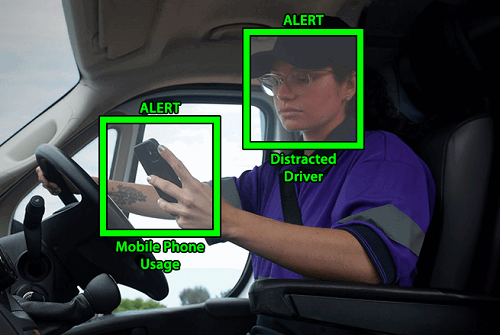Advances in fleet and video telematics, increasingly powered by AI and machine vision, are making it much easier and quicker to spot, correct and therefore prevent unsafe driver behaviour, like speeding.
Features
Fleet and video telematics: why prevention is now key
With around 90 per cent of crashes a result of driver error or distraction, there is a huge opportunity for vehicle operators to improve road safety, better protect drivers and reduce associated costs by taking a proactive approach to prevention. Of course, there will always be other factors involved in these collisions, but if you can eliminate the human element by encouraging drivers to correct issues then you will achieve meaningful risk reduction.
 Post-event machine vision effectively means that the video telematics software views the video clips for you and flags up those that need attention. Photograph: Inseego UK Ltd
Post-event machine vision effectively means that the video telematics software views the video clips for you and flags up those that need attention. Photograph: Inseego UK Ltd
The insurance industry is certainly embracing prevention, having for years focused on first notification of loss (FNOL). What we are now seeing is a switch towards first notification of risk (FNOR) as insurers recognise the added benefit of identifying where threats exist and doing something about it. From a fleet perspective, if you can become a low-risk operation, it’s possible to not only save lives, but also associated costs.
AI-powered fleet technology
Traditional vehicle cameras record a collision, allowing investigation after the event, but with advances in AI dashcams, fleets can tackle risk and prevent incidents happening in the first place. Using the latest developments in machine vision and artificial intelligence (MV and AI), it is possible to detect and help drivers self-correct dangerous or distracted behaviour. Therefore, it becomes more about the prevention rather than the cure.
The AI dashcams provide a greater understanding of risky behaviour and distraction within the vehicle, such as using a mobile device, eating and drinking, and eyes off the road. The MV-and AI-capabilities work together to identify and assess risk in and out of the vehicle, so the driver can be notified of any issues. We have seen some driver pushback against these devices, but any initial reluctance has quickly been replaced by an understanding that the cameras are having a positive effect on risky driving habits and improving their safety.
Meanwhile, the overwhelming amount of data captured from telematics technology is one of the biggest issues we see from a fleet manager’s perspective. Many simply don’t have the time or resources to convert the information into actionable insight, so it’s about using clever tools and processes to capture, measure and use the data. For example, vehicle cameras typically upload video clips based on g-force trigger events. For a fleet of 50 vehicles, if each generates four clips per day, the fleet manager would have 1,000 videos to watch in a week, which is simply not workable.
 Graphic: Inseego UK Ltd
Graphic: Inseego UK Ltd
Post-event machine vision effectively means that the video telematics software views the video clips for you and flags up those that need attention. This means a fleet manager can quickly focus on actual collisions or an incident where a vulnerable road user (pedestrian, motorcyclist or cyclist) was involved rather than false positives generated by harsh driving, potholes and speed bumps. The AI technology has been shown to reduce the number of clips needing review by as much as 99 per cent, leaving just a handful that can be checked in a matter of minutes.
The true risk of speeding
Speeding is a major contributing factor in many road collisions. When you then take into account that around two-thirds of all crashes in which people are killed or injured happen on roads with a speed limit of 30mph or less, the scale of the challenge for fleets in urban areas is clear. It is therefore crucial to consider severity of speeding alongside frequency to see where the highest levels of risk exist within a vehicle operation.
Comparing against road limits and vehicle types helps provide the context and understanding needed to identify true risk, because not all speeding should be considered the same. Is someone who consistently drives marginally above the speed limit on a motorway worse than someone who sometimes drives above 40mph past a school? A traditional vehicle tracking system would probably say so, but the latest speed band reporting measures the severity of events and weights them accordingly.
Ignoring high-risk speeding, especially in urban areas, has significant consequences in the event of a collision.
 Steve Thomas: "Fleet and video telematics has a huge role to play in any risk reduction strategy."
Steve Thomas: "Fleet and video telematics has a huge role to play in any risk reduction strategy."
A vehicle travelling at 20mph can typically stop in 12 metres or less if a pedestrian crosses in front of them, but at 30mph the vehicle is likely to hit the same pedestrian at 27mph and at 40mph would not slow at all. Now consider that if someone is struck at 20mph the survival rate is 90 per cent, but this drops to 50 per cent at 30mph and just 10 per cent at 40mph. As these figures show, fleets have a huge responsibility to ensure that their drivers keep to speed limits to mitigate the risk of serious injury or loss of life.
Automating driver communication
The next step will be to completely automate driver communication to reduce the burden on the fleet manager. Ultimately, telematics is about altering behaviour, but historically this has been the responsibility of the fleet manager to use performance data to directly engage with the driver.
At Inseego, we want to see a system that can be set up to analyse the available vehicle and driver information and automatically take steps to encourage change. This is already happening around driver behaviour monitoring and training where the telematics system can detect high-risk actions – such as speeding or harsh driving – and send the driver an appropriate message or training module. If moving forward, we can make it handle other aspects of fleet management including compliance, vehicle usage and working hours, the technology will take on much more of the hard work and the benefits will be seen throughout the organisation.
Managing work-related road risk is a complex issue for any fleet organisation. Fleet and video telematics has a huge role to play in any risk reduction strategy, but moving forward it will become more about adopting preventative measures that help drivers avoid collisions in the first place.
For more information see: inseego.com
Steve Thomas is Managing director at Inseego UK Ltd
FEATURES

Sedentary working and how to combat the ‘sitting disease’
By Gavin Bradley, Active Working on 05 April 2024
Prolonged and excessive sitting poses a major risk to our health, but the Get Britain Standing campaign and On Your Feet Britain Day on 25 April are a great way of encouraging workers to sit less and move more.

Company culture and wellbeing: a crucial link
By Bex Moorhouse, Invigorate Spaces on 05 April 2024
Investing in measures to support worker wellbeing will be ineffective unless the company culture genuinely incorporates values like teamwork, involvement, flexibility and innovation.

Office design and culture: happier and healthier staff – or the opposite?
By Guy Osmond, Osmond Ergonomics on 03 April 2024
Applying ergonomic principles to workstation set-ups and ensuring the physical environment supports neurodivergent people are just some of the ways of creating an office where everyone can thrive, but a supportive and positive organisational culture is vital too.


